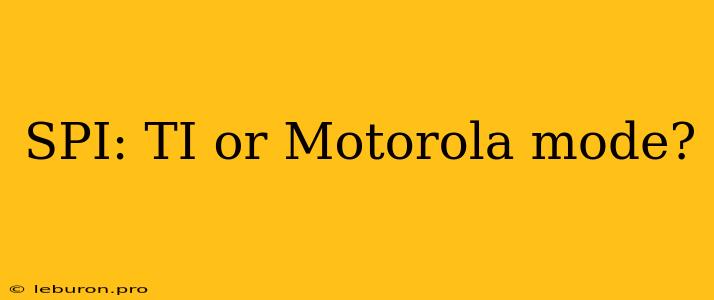SPI: TI or Motorola Mode? Choosing the Right Protocol for Your Application
The Serial Peripheral Interface (SPI) is a synchronous serial communication protocol widely used in embedded systems and other applications where data needs to be transferred between devices. SPI offers several advantages, including its simplicity, low cost, and high speed, making it a popular choice for a variety of use cases. However, within the SPI framework, there are two common modes of operation: TI mode and Motorola mode, each with distinct characteristics that influence their suitability for different applications. Understanding the differences between these two modes is essential for selecting the most appropriate one for your specific project.
Understanding SPI Modes
Both TI mode and Motorola mode are based on the same fundamental SPI principles, but they differ in their interpretation of the most significant bit (MSB) and least significant bit (LSB) order during data transmission. Let's delve deeper into the specifics of each mode:
TI Mode (MSB First)
TI mode, also known as Motorola mode, transmits data with the most significant bit (MSB) sent first, followed by the remaining bits in descending order. This is often referred to as MSB first. In essence, the data is transmitted in the same order as it is stored in memory.
Example: For a 8-bit data value of 0xAB, the transmission sequence in TI mode would be:
- A (MSB)
- B
- 0
- 0
- 0
- 0
- 0
- 0 (LSB)
Motorola Mode (LSB First)
Motorola mode stands in contrast to TI mode by transmitting data starting with the least significant bit (LSB) first, with the MSB sent last. This is often referred to as LSB first. In this mode, the order of data transmission is the reverse of how it is stored in memory.
Example: Using the same 8-bit data value of 0xAB, the transmission sequence in Motorola mode would be:
- 0 (LSB)
- 0
- 0
- 0
- 0
- 0
- B
- A (MSB)
Choosing the Right Mode
The choice between TI mode and Motorola mode largely depends on the specific requirements and characteristics of your project and the devices involved.
Here's a breakdown of factors to consider:
- Device Compatibility: Different microcontrollers and peripheral devices may have different default SPI modes. Consult the datasheets of your components to ensure compatibility.
- Data Format: If your application involves transferring data in a specific format where the order of bits matters, select the mode that aligns with that format.
- Interoperability: If your system involves communication with other devices, ensure that both devices operate in the same SPI mode.
- Software Support: Some software libraries or development environments may have specific functions or settings for handling different SPI modes.
Example Scenarios:
- Microcontroller Communication: When using an SPI interface to communicate between two microcontrollers, both should be configured to operate in the same SPI mode.
- Sensors: If your application involves reading data from sensors, refer to the sensor's datasheet to determine its preferred SPI mode.
In summary, TI mode and Motorola mode both have their merits and drawbacks. Choosing the correct mode is critical for ensuring proper data communication in your SPI-based systems. By carefully considering the factors discussed above and understanding the specific requirements of your project, you can select the appropriate mode for optimal performance and interoperability.
Conclusion
Understanding the differences between TI mode and Motorola mode is vital for successful implementation of SPI communication in embedded systems and other applications. By carefully choosing the correct mode, you can ensure reliable data transfer and interoperability between your devices. Remember to consult the datasheets of your components and consider the specific requirements of your project to make an informed decision about which SPI mode to utilize.
